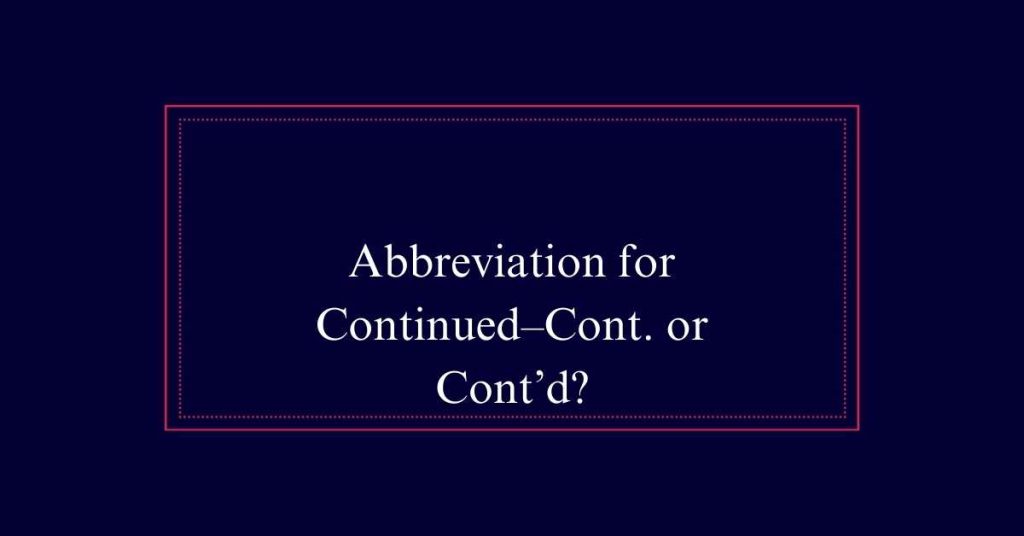Abbreviation for Continued–Cont. or Cont’d?
The abbreviation ‘cont.’ is the preferred form for ‘continued,’ as recommended by the Chicago Manual of Style. This abbreviation is widely accepted in academic and professional contexts, ensuring clarity and consistency. While ‘cont’d’ is also a valid alternative, ‘cont.’ is generally considered more standard and polished. Consistently using ‘cont.’ reflects attention to detail and adherence to style guidelines, enhancing the professionalism of your writing.
Abbreviation Guidelines
When abbreviating ‘continued,’ the Chicago Manual of Style recommends using ‘cont.’ This abbreviation is widely accepted in academic and professional writing. Using ‘cont.’ is essential for consistency and adherence to established style guidelines.
Another option is ‘contd,’ which is also a valid shortening. However, ‘cont’ should be avoided, as it mixes abbreviation and contraction, leading to potential confusion.
Following specific style guides is vital for maintaining clarity and professionalism in your writing. By using the recommended abbreviations, writers can effectively communicate that a text will continue on the next page or section.
Chicago Manual of Style
The Chicago Manual of Style provides detailed guidelines for proper abbreviations and contractions in professional writing. It recommends using ‘cont.’ as the standard abbreviation for ‘continue’ or ‘continued.’ This form is widely accepted in academic and professional contexts.
The manual suggests avoiding ambiguous or non-standard abbreviations that may confuse readers. While ‘contd’ is grammatically correct and similar to contractions like ‘can’t,’ it is less commonly endorsed by style guides.
Following the Chicago Manual’s guidelines guarantees clarity and consistency. Adhering to these standards not only improves readability but also maintains the professionalism of the document.
Proper abbreviation usage is a small yet significant detail in effective communication.
Academic and Professional Use
Adhering to established abbreviation guidelines is particularly important in academic and professional contexts. Using the correct abbreviation such as ‘cont.’ or ‘cont’d’ can impact the clarity and professionalism of your work. Precision in language usage guarantees that your writing is understood and respected by your peers and colleagues.
- Consistency: Always use the same abbreviation throughout your document.
- Clarity: Choose an abbreviation that best maintains the meaning of the original word.
- Professionalism: Proper abbreviations reflect a high standard of writing.
- Readability: Clear abbreviations help readers follow your work seamlessly.
- Guidelines: Refer to relevant style guides to guarantee correct usage.

Style Guide Adherence
Style guides provide essential standards to guarantee consistency and professionalism in writing. They offer specific rules for abbreviations to make sure of clarity. For ‘continued,’ the Chicago Manual of Style recommends ‘cont.’ This maintains uniformity across documents. Adhering to these guidelines is important in professional settings as it reflects attention to detail and credibility. Below is a comparison of common style guides and their recommendations:
| Style Guide | Abbreviation for Continued |
|---|---|
| The Chicago Manual of Style | cont. |
| AP Stylebook | cont. |
| MLA Handbook | cont. |
| APA Publication Manual | cont. |
Using ‘cont.’ aligns with these standards, making sure your writing remains polished and professional.
‘Contd’ as an Option
While ‘cont.’ is widely accepted, ‘contd’ also serves as a valid abbreviation for ‘continued.’ This form shortens the word by dropping certain letters and adding an apostrophe, making it a practical alternative. Though not explicitly mentioned in style guides, ‘contd’ is grammatically correct and can be used effectively in various writing contexts.
Here are some key points about using ‘contd’:
- Practicality: Offers a concise way to indicate continuation.
- Clarity: Guarantees clear understanding for the reader.
- Flexibility: Suitable for both professional and informal writing.
- Consistency: Matches other common contractions like ‘can’t’.
- Professional Appearance: Maintains a clean, organized look in documents.
Contraction Vs. Abbreviation
How do contractions differ from abbreviations in professional writing? Contractions combine two words into one by omitting certain letters and often using an apostrophe. Examples include ‘can’t’ for ‘cannot’ and ‘cont’d’ for ‘continued.‘ They are common in informal writing but less so in formal contexts.
Abbreviations, on the other hand, shorten words by omitting certain letters without replacing them with an apostrophe. Cont.’ is an abbreviation for ‘continue.’ Abbreviations are widely accepted in academic and professional writing for their clarity and brevity.
Understanding the difference helps uphold appropriate language use. Contractions may be seen as less formal, while abbreviations are suitable for professional documents. This distinction guarantees precision and adherence to writing standards.
Non-Style Guide Usage
In contexts where specific style guides are not strictly followed, the choice between ‘cont.’ and ‘cont’d’ can vary based on preference and readability. Different settings may have unique conventions. Here are some points to take into account:
- Audience: Know who will read your document. Use what they find easiest.
- Context: Reflect on the type of document. Informal settings might allow more flexibility.
- Consistency: Stick to one form throughout the document to avoid confusion.
- Clarity: Choose the abbreviation that makes the text clearer.
- Space: In tight spaces, a shorter form like ‘cont.’ may be beneficial.
Next Page Indicators
Clearly indicating that content continues on the next page is crucial for maintaining reader engagement and document organization. This practice guarantees that readers do not miss important information and can easily follow the flow of the text.
Common phrases like ‘Continued on next page’ or ‘Continued on page X’ signal readers to look elsewhere for the continuation. These indicators are especially useful in tables, forms, and non-adjacent newspaper articles.
Proper use of next page indicators helps keep documents organized and easy to navigate. They also enhance the overall readability of the document, ensuring that readers remain engaged and informed throughout their reading experience.
Clarity in Continuation
Ensuring clarity in continuation is important for maintaining the reader’s understanding and engagement throughout the document. Proper use of abbreviations like ‘cont.’ or ‘cont’d’ helps in this regard. Clear continuation indicators prevent confusion and promote smooth reading.
Here are essential points to keep in mind:
- Consistency: Use the same abbreviation throughout the document.
- Style Guide Adherence: Follow the specific style guide for your document.
- Visibility: Place continuation indicators where they’re easily noticed.
- Simplicity: Choose the simplest form for easy comprehension.
- Context: Ensure the abbreviation fits the document’s context.
Professional Writing Standards
Adherence to professional writing standards is essential for maintaining credibility and clarity in any document. Using correct abbreviations such as ‘cont.’ or ‘cont’d’ is a sign of professionalism. These standards not only improve readability but also guarantee consistency across documents. Below is a simple table outlining key points:
| Aspect | Correct Usage | Impact |
|---|---|---|
| Abbreviations | ‘cont.’ or ‘cont’d’ | Enhances readability |
| Style Guide Adherence | Follow guidelines | Maintains credibility |
| Consistency | Uniform usage | Improves document flow |






